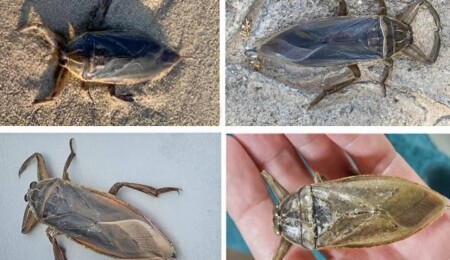Massive Bug Sighted: Keep Your Toes Out of The Water

Scientists have identified a giant water bug, known as the toe-biter, along the shores of Cyprus.

The species, known to inhabit lakes and slow-moving freshwater, had never been recorded on the island before, although established populations are known in neighbouring Mediterranean countries such as Greece, Turkey and Israel.
Experts have urged the public to remain vigilant.
“Cypriots should keep their eyes open and their toes out of the water,” they warned.
A team of scientists from various institutions in Cyprus are studying this elusive toe-biter led by Michalis Hadjikosnstantis of the Cyprus Natural Heritage and Biodiversity Protection Society, alongside Yiakoumis Giortzis from the agriculture ministry and Kadir Boğaç Kunt from the Cyprus Wildlife Research Institute.
Their findings, published in the prestigious journal Travaux du Muséum National d’Histoire Naturelle Grigore Antipa, reveal the characteristics of the large insect.
Also referred to as the “electric light bug”, this enormous aquatic insect is characterised as a formidable predator, hunting down invertebrates, fish, turtles and even birds. Adding to its intimidating nature, it holds the title of being the largest true bug and water insect in Europe, boasting a diameter of up to 12 cm, and is infamous for delivering excruciatingly painful bites when provoked.
The information was gathered after the scientists collected samples from an increasing number of sightings of the giant water bug on the eastern coast of the island in late spring and summer of 2020 and 2021.
Its appearance, mainly on the eastern coastal front of the island, was initially recorded by swimmers who were astonished by the terrifying appearance and size of the creature. They either directly contacted experts or posted photos and videos on the internet, mainly in Facebook groups related to biodiversity. After that, scientists collected some of the samples for further study. They also conducted extensive online searches on relevant observation platforms to track any other reports of the species on the island. Additionally, they sampled nearby wetlands but did not find the bug.
“Nature enthusiasts searching for alien creatures can provide valuable information about the presence and potential establishment of the species through citizen science,” the authors of the relevant article noted.
Ultimately, a total of seven sightings were recorded: five from social media and two after direct communication with the author’s team. Two samples were taken and morphologically examined to verify the species.
The authors of the article speculate that it’s improbable for the creature to have remained unnoticed for an extended period, given the fear it instils in those who come across it. They suggest that the sudden appearance of the species may be linked to migratory events triggered by neighbouring countries hosting the creature, such as Israel, Lebanon and Syria. It’s possible that samples were carried by wind or ocean currents, as proposed by other researchers, or due to a decrease in food resources in their original habitat.
Despite numerous sightings within a short timeframe, drawing conclusions about the species’ establishment on the island is premature. Further investigation is required.
Source: Cyprus Mail


Comments
Attention!
Sending all kinds of financial, legal, criminal, administrative responsibility content arising from illegal, threatening, disturbing, insulting and abusive, humiliating, humiliating, vulgar, obscene, immoral, damaging personal rights or similar content. It belongs to the Member / Members.